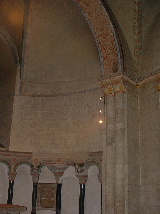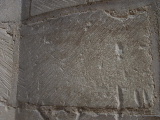


____________________________________________________________
"In the heart of fertile East Anglian countryside, Norwich, one of the best
preserved cities in Britain, is steeped in a relaxed provincial atmosphere.
The town was first fortified by the Saxons in the 9th century and still has
the irregular street plan of that time. With the arrival of Flemish settlers
in the early 12th century and the establishment of a textile industry,
the town soon became a prosperous market and was the second [largest] city in England
until the industrial revolution in the 19th century (208)."
We toured the Norwich Cathedral, founded in 1076, the second tallest in England. In the last picture can be seen a mason mark. It is a third of the way across the stone from the left (looks like two triangles connected at the tips). The masons shaped the stone soon after it was unearthed, because the longer it dries, the more difficult it is to shape. They marked the stones with their mason marks, so that the church would know whom to pay for the stone-cutting. In the first picture colored stone can be seen. Churches were originally very colorful, but during the reformation the coloring was either scrubbed away or painted over. The sections which were scrubbed cannot be restored of course, but those that were whitewashed can be restored.
Next was the Castle Museum. Built in the 12th century by the Normans, it functioned as a castle, palace, prison, and now museum throughout its history. The funny looking clear thing is the lift (elevator) for the crippled, lazy, or elderly.
We also took a quick walk through the city centre. Since we were both hungry, we bought crepes from a little stand because the French market was in town - Justin got a Hawaiian one (ham, pineapple, cheddar); Erin got apple and cinnamon.